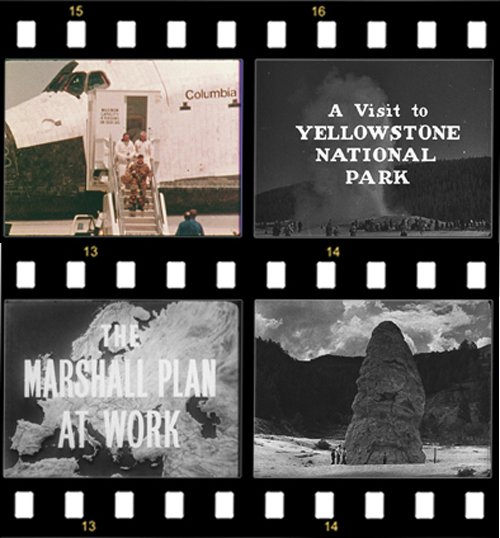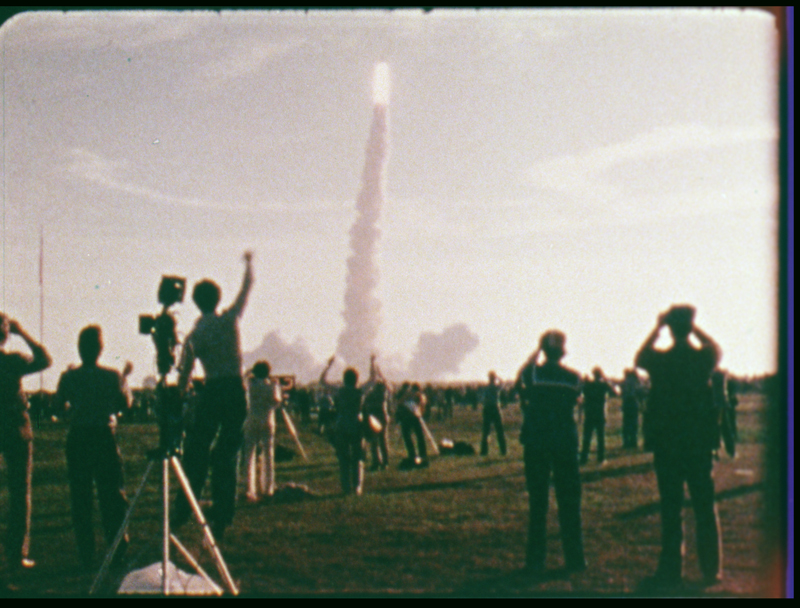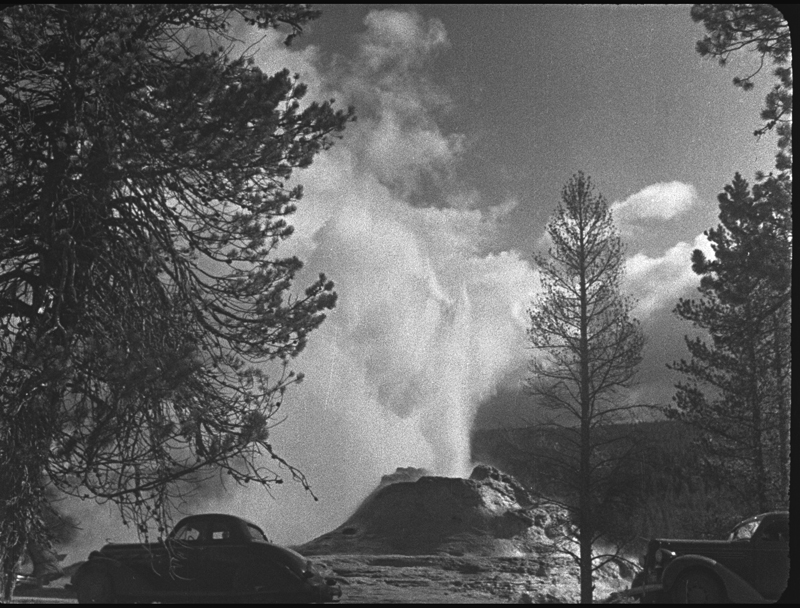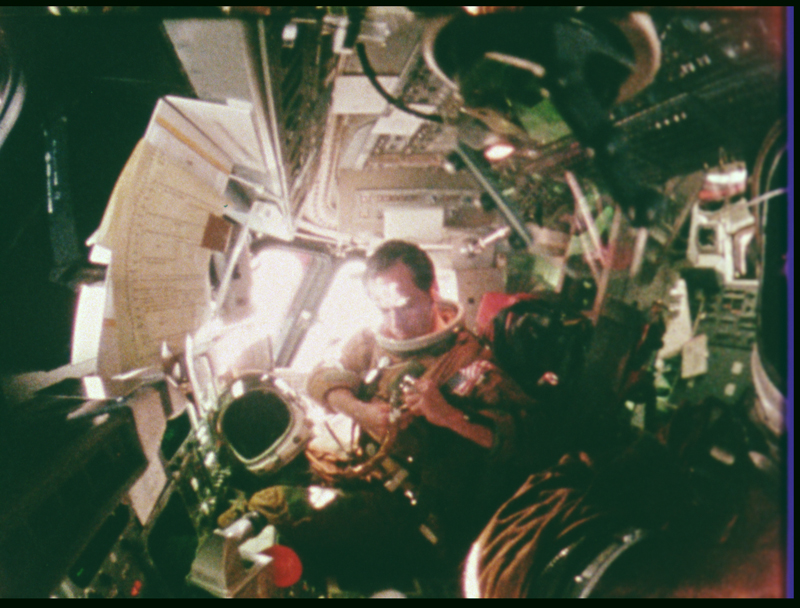
Frame After Frame
Summer 2010, Vol. 42, No. 2
Frame After Frame
Taking a Look at the Motion Picture Collections in the National Archives
By Phillip W. Stewart
© 2010 by Phillip W. Stewart
"Produced by the Work Projects Administration . . . Produced by the National Aeronautics and Space Administration . . . Produced by the U.S. Air Force . . . Produced by the Agency for International Development . . ."
These motion picture production credits refer to only a few of the hundreds of federal government agencies and organizations cited in the closing credits of motion pictures held within America's film vault, the National Archives. Added to these are titles donated from film collectors, small independent production companies, and even the major television networks. All in all, there are more than 108,000 motion picture titles available for study and review in the Archives.
The National Archives and Records Administration (NARA) has amassed one of the largest and most historically rich documentary film collections in the world. As the official repository for permanently valuable federal records, it possesses over 360,000 reels of film dating from the 1890s to the end of the 20th century. These films are part of 349 federal and donated motion picture collections within NARA. More than 75 percent of the films are in the safekeeping of the Motion Picture, Sound, and Video Branch of the Special Media Archives Services Division, located at the National Archives in College Park, Maryland. The rest are housed in NARA presidential libraries and regional archives located around the country.
The various motion picture collections, like other records in NARA, are organized by record group (RG). Each record group contains the records of a federal entity, such as an agency, department, or bureau. The motion pictures are predominately documentary-type films, but educational, informational, instructional, and newsreel categories also make up portions of the overall collection. There are a few theatrical titles as well. Most of these films were made or acquired by Uncle Sam without restrictions and are, therefore, free of copyright and are royalty free. However, there are a number of films, especially in the Donated Materials collections, that do have copyright or use restrictions. The Motion Picture, Sound, and Video research room staff can clarify and provide guidance to researchers.
In order to get an idea of the vast scope of the subjects covered and the titles held within NARA film holdings at College Park, this discussion divides the record groups that contain motion pictures into three categories: Civilian, Military, and Donated.
America at Peace and War: The Civilian Agency Films
The National Archives has a wealth of motion picture titles that document the civilian side of the federal government. This category is the largest in terms of represented agencies, with 159 record groups. An example of an early government-made film is An American in the Making (1913), which was produced by the Bureau of Mines (RG 70) and documents the assimilation of immigrants into American society. A glimpse of how the New Deal handled the Great Depression can be seen in the motion picture Hands (1934) from the Work Projects Administration (RG 69). Films concerning Civilian Conservation Corps camps, soil and forest reclamation, development of water power, and the recreational use of national parks include films like A Visit to Yellowstone National Park (1937) and Power and the Land (1940), from the Office of the Secretary of the Interior (RG 48) and the Department of Agriculture (RG 16), respectively.
Civilian government agency World War II–era titles like Joe Comes Back (1943), Family Feud (1944), German Reprisals: Destruction in Greece (1944), and A Challenge to Democracy (1945) document our government's efforts to communicate with foreign and domestic civilian populations. They were produced by the War Production Board (RG 179), Office of War Information (RG 208), Office of Strategic Services (RG 226), and the War Relocation Authority (RG 210), respectively. These titles are just a few of the more than 2,100 films within those four record groups. Axis motion pictures, captured before the end of hostilities or seized during the Allied occupation and used to document war crimes, like Japan in Time of Emergency (1933) and With Our Air Force in Sudetenland (1938), are among the films included in the National Archives Collection of World War II War Crimes Records (RG 238) and the National Archives Collection of Foreign Records Seized (RG 242).
Motion pictures from the Department of State (RG 59) deal with U.S. foreign policy and foreign relations issues; The Marshall Plan at Work in Great Britain (1951) is a fine example. The U.S. Information Agency (RG 306) produced documentaries for distribution abroad about the many aspects of life in the United States. Among its 17,000-plus reels of film are titles like Pursuit of Happiness (1935), The Country Store (1950), Presidential Nomination (1956), and Music in American Education (1969). The Agency for International Development (RG 286) examines foreign aid, economic and rural development, and lifestyles and cultures and documents AID projects in developing countries with films like Kitchen Come True (1945), Giant in the Sun (1957), and Ambassador: The Life and Work of a Man (1979). Reels with the titles Republic Steel Strike (1937) and Baltic States Investigation: Hearing Before the Select Committee to Investigate the Incorporation of the Baltic States into the U.S.S.R. (1954) are among the records of the U.S. House of Representatives (RG 233) and the U.S. Senate (RG ¬46).
The U.S. space program is documented in the motion pictures of the National Aeronautics and Space Administration (RG 255). The collection consists of over 11,500 reels of edited and unedited films, including titles like Project Mercury: Western Electric Range Report for August (1960), TR-3268 Fixed Wing Aerial Recovery Demonstration (1967), and Space Shuttle: A Remarkable Flying Machine (1981).
Social concerns ranging from housing to poverty are addressed in films like Unfair Housing Isn't Unfair; It's Illegal (1969) and A New Life for Rose: The Program of a Senior Housing Project (1976), which are in the records of the Department of Housing and Urban Development (RG 207). Motion pictures from the Department of Labor (RG 174) focus on labor-management business relations, unemployment, status of the economy, and job opportunities, as seen in films like Pin Money (1940) and Harvest of Shame (1960).
On the Home Front and "Over There:" The Military Agency Films
In terms of number of reels, the motion pictures of the U.S. military services represent the largest film collection in the Archives. There are primarily four reasons for this. First, our country was repeatedly involved in wars and conflicts during much of the 20th century. Second, the War and Navy Departments and their successor, the Defense Department, valued motion pictures for documentation of operations, campaigns, training, education, troop orientation, and public relations. Third, even before the National Archives was established, the Army safeguarded and extensively cataloged their film titles and retained their negatives, masters, and prints. Last, the Department of Defense initiated a program of nitrate film conversion that saved tens of thousands of historic reels from decay. Because of these efforts, the Motion Picture, Sound, and Video Branch now holds film that dates from the beginning of the last century in 40 military record groups.
During World War I, the U.S. Army Signal Corps (RG 111) documented America’s involvement, and its collection contains more than 480 titles consisting of almost a half-million feet of film on approximately 990 reels shot during the 1917–1919 period. Films such as Cavalry Training in the U.S. (1917) and Aisne-Marne Operations, July 18–August 6, 1918, 42nd Division (1918) are excellent examples. Over 12,000 more titles in this record group cover Army life, maneuvers, and battles up to 1980.
Activities of the U.S. Navy (RG 428) fill about 13,300 reels from before World War I through 1980 with titles like USS Holland (Submarine) Trials (1904), Invasion of Guam: Activity Aboard USS New Mexico (1944), and Poseidon Launch (1971). Approximately 2,900 reels of motion pictures from the U.S. Marine Corps (RG 127) dating from World War I to the late 1970s, include such titles as Soldiers of the Sea (1939) and Hawk Missile Firing, 29 Palms, CA (1962).
The U.S. Air Force Commands, Activities and Organizations (RG 342) cover early aviation and Air Force activity from 1906 to the early 1990s with over 8,900 reels. Titles like Activities of the 94th Aero Squadron (1918), Dedication of Wright Field (1927), Capt. Robert S. Johnson, Fighter Pilot (1944), USAF "Goodwill" Tour (1954), and TAC Operations, Homestead AFB (1962), are fine representative examples.
All theaters of military activity during World War II, the occupation of Germany and Japan, war crimes trials, and the Korean and Vietnam conflicts are well documented within these record groups.
Americana: The Donated Material Films
Gifts to the National Archives make up a large segment of the overall collection. Donated films are usually personal or organizational motion pictures that have been received by the National Archives under a deed of gift. By definition these are not federal records and may be under access restrictions imposed by the donor. These films are preserved because they are directly related to other federal records. They also serve to enlarge and illustrate the history of the United States and of the American people.
Probably the oldest film in the custody of NARA is in this category. Carmencita, Spanish Dance (1894), a Thomas A. Edison Kinetoscope from the Thomas Armat Collection (ARMAT-ARMAT), is now 116 years old. Also included in the donated category are newsreel collections from Fox-Movietone (FOXMN-MN), 1927–1964; Hearst (HSRT-ND), 1963–1967; Paramount (PARA-PN), 1937–1957; and Universal (200-UN), 1929–1967. Other notable film collections in this category include the Ford Motor Company (FC-FC), 1903–1954; the Longines-Wittnauer Watch Company (LW-LW), 1951–1955; and the March of Time (MT-MT), 1934–1953. At this writing, there are a total of 161 Donated Material collections that contain motion pictures.
Another fine example of a donated motion picture collection is from the Harmon Foundation. William E. Harmon established the foundation in 1922 to fund parks and playgrounds in growing communities and to provide loans for students. By 1967, when the foundation ceased its activities, its scope encompassed community and family life, education, religious beliefs, and the art and culture of minority and ethnic groups. The 300 or so motion picture titles, which date from 1930 to 1951, document arts, crafts, and societies throughout the world with particular emphasis on Native Americans, African Americans, Africans, Mexicans, and Chinese. Harmon Foundation films (H-HF) such as The American Indian: When the White Man Came and After (1933) and Ceramics Is a Disciplined Art: Use of the Potter's Wheel (1949) were donated without restrictions.
The Archival Research Catalog
In an effort to allow enhanced access to all its holdings, including historic motion pictures, NARA developed the online Archival Research Catalog (ARC). This is the latest web-based research tool that provides a portal to the content and physical descriptions of archival materials. ARC is continually growing, and every week new descriptions are added. As of the summer of 2010, about 68 percent of NARA's records were described in ARC. Even so, as the archivists remind researchers, "Just because it's not in ARC doesn't mean it's not in our holdings." Learn and use ARC at www.archives.gov/research/search/ to review the latest catalog updates.
Once on the ARC home page, enter a subject or title into the blank box, and press Search. After you get your first list of results, find and select the Refine Search button. This will bring up the Archival Descriptions Advanced Search page. Make sure that the Limit Results button is set at 2,000, and then select Highlight Search Terms. These settings will ensure that you get the greatest number of hits on your subject and that all matching words will be highlighted in yellow. Now scroll down the page, and you'll find a section called Type of Archival Materials. Since you are looking for film footage, deselect all the types listed except Moving Images. This will narrow your next set of search results to motion picture and video items. Then click on the Search button, and you should find a cleaner and highlighted film list to review.
Once you have read through the search results, selected some, and read the descriptions, you'll probably end up with a list of titles that you'd like to see. Regrettably, your options for viewing the films are somewhat limited.
Viewing Options
First, you can visit the National Archives in College Park and view the titles in the Motion Picture, Sound, and Video research room. If you choose to do this, it’s best to send an e-mail to the staff in advance of your visit (mopix@nara.gov), with the title and ARC identification number, to determine if a reference copy of the title is available on either film or videotape. If no reference copy exists, you may request that one be made, at no cost to you. The only downside to this process is that it may take several weeks.
Another option is to hire a private film researcher to make VHS or DVD reference copies of your selected titles and have them sent to you. For those who live outside a reasonable driving distance of College Park, this may be a viable cost option when compared to the price of an airline ticket. A list of researchers is available at www.archives.gov/research/hire-help/.
Over the last few years, NARA has partnered with video production and distribution companies that have produced a number of DVDs that contain a small percentage of the titles in the 349 collections in America's film vault. Therefore, you might want to search online sources like Amazon, Barnes and Noble, or your favorite DVD retailer for the titles on your list.
With the explosive growth of the Internet, and the fact that most of the film collections in the NARA are not under copyright, some titles are now accessible as streaming video via various web sites. Google Videos, Internet Archive, and YouTube come to mind (NARA's own YouTube channel may be found at www.youtube.com/USNationalArchives). So, lastly, you may want to search the web for your title; you never really know what's out there in cyberspace.
That's a Wrap!
This country is fortunate to have such a rich collection of motion picture recorded history. However, with the possible exception of the Universal Newsreels, much of the NARA film collection is seldom seen by the general public and is underutilized as a historic resource. Only through regular reminders, enhanced use of the footage by media producers, and its increased application as a historical research tool, can the American people and their elected officials ensure that it's preserved and accessible for future generations. Frame-by-frame, it's worth cherishing.
Phillip W. Stewart is an award-winning author of six NARA motion picture-related reference books: Battlefilm: U.S. Army Signal Corps Motion Pictures of the Great War; War Wings: Films of the First Air War; Projected History: A Catalog of the National Stories Produced by Universal Newsreel, Volume One and Volume Two; America's Film Vault: A Reference Guide to the Motion Pictures Held by the U.S. National Archives; and Aerial Aces of the Universal Newsreel, 1929–1931. His article "Battlefilm" appeared in the Summer 2008 issue of Prologue.



